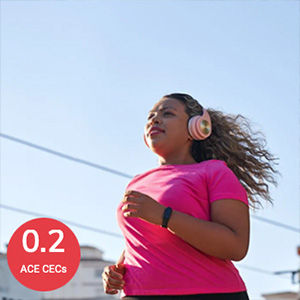
Clients often come to health coaches and exercise professionals with loosely defined goals. Perhaps they want to “improve health” or “increase energy.” Maybe they’re looking to “tone up” or “trim down.” It’s our job to both assist clients in drilling down these goals into specific outcomes as well as help them determine appropriate metrics by which success can be measured. For many new clients, weight loss is often the only anticipated measure of improvement. However, the number on the scale is only a glimpse of what’s shifting in your client’s body (and mind) and offers limited information about their progress. This article explores alternative metrics that you, as a health and exercise professional, can use to assess your clients on their behavior-change journey.
Process vs. Outcome Goals
Before setting goalposts to measure client success along the way, both the client and coach must be clear on the ultimate destination. An outcome goal is typically defined as the place clients are hoping to go through the support of the coaching relationship. When talking with clients about their outcome goals, clarity is key.
“First and foremost, I think it is important to get very clear on what ‘success’ looks like for the individual client, because every client is going to have a different goal,” says Madison Deaton, owner of The Fit Flamingo in Dallas, Texas.
To gain insight, ask clients open-ended questions to determine exactly what they seek. For example, if the client mentions wanting to improve energy, get curious about when in the day their energy is low, what increased energy would look like, or, perhaps most importantly, what value this would bring to their life.
Once the outcome goal(s) are clear, the next step is to develop process goals. These are behavior-related goals that involve the actual practices clients will perform. In the example of increased energy, process goals might include setting up and following a sleep routine or finding and eating foods that energize the client. This step is always collaborative and accounts for the client’s interests, abilities, likes and dislikes.
Both outcome and process goals should be tracked as metrics. Let’s take a deeper look into each of these goal types and the various ways they can be tracked.
Embracing Technology for Real-time, Holistic Metrics
Recent advancements in wearable technology and mobile health applications enable you to track a broader array of indicators. Modern wearables not only monitor physical activity and sleep patterns but also capture data on heart rate variability, stress levels and even skin temperature—factors that inform recovery and overall cardiovascular health. Additionally, digital platforms can integrate dietary logs, mood tracking and biomarker data (such as blood pressure or glucose levels), offering a consolidated view of your clients’ overall well-being.
Process Goals
Rather than focusing solely on distant, long-term goals, setting up the actual process as a way to measure success is useful in boosting client morale.
“I like to gauge success based on how much a client learns about healthy, balanced eating and develops a healthier relationship with food, using nutrition as a source to fuel themselves throughout the day and support performance,” says Christy Alexon, PhD, RD, a clinical professor of nutrition at Arizona State University. “When clients start to feel more energized and have a more positive outlook as a result of healthier eating habits, I consider this the ultimate success.” A focus on action steps helps clients stay motivated when they have not yet reached their intended outcomes.
Further, in contrast to outcome goals, process goals are directly within a client’s control. While they can’t manipulate changes in energy, mood, blood biomarkers or weight, they can control the behaviors that will move them toward improvement in those areas. Process goals can be particularly helpful when progress toward outcome-centered goals is slow. Tracking and accomplishing process goals not only moves the client in the direction of their long-term goals, it sets the stage for celebrating the steps taken throughout the journey itself and not just when the destination is reached. This can be impactful, especially when building self-efficacy toward a target behavior.
There are many factors involved in the development and implementation of process goals. Though the first step of setting the goal is crucial, the follow-up steps are equally important. Some of these steps include determining the appropriateness of selected action steps, setting up accountability, brainstorming ways to overcome barriers and safeguarding against the development of shame that can creep up when people try to change behaviors.
Determining Appropriate Action Steps
As a health and exercise professional, you likely have a repertoire of healthy action steps clients can take to move toward their goals. As much as possible, action steps should be client-generated, where the client determines the next best step to move them forward. This increases the likelihood that a goal fits within the context of a client’s life and the probability that it will be completed.
“It’s important for me to have a deeper, one-on-one conversation with each one of my clients to see where they’re at,” says Deaton. “What are their pain points? Do they struggle with mental health or an eating disorder? Have they experienced some form of physical or emotional trauma? Is self-love, confidence or body image an area for improvement? If topics like these are uncovered during this explorative one-on-one conversation, it is important to recognize and respond to opportunities for referral as a first actionable step in this newly formed partnership.” Deaton affirms the importance of drilling down to uncover potential issues requiring referral to a more qualified health professional and when appropriate working with clients to set process goals that are realistic and relevant to their circumstances.
Accountability
Often, clients seek coaching for the accountability alone. Many clients share that they “know what to do, but they just can’t seem to do it.” To help clients stay on track, accountability need not be punitive. Letting your clients know from the beginning that there are no failures, only learning experiences, and that you will provide a safe space to be honest about action steps and maintain accountability. Work with your clients to determine what kind of accountability, and at what frequency, works for them. Recording target behaviors also provides an opportunity for clients to self-monitor their own actions. This allows clients to hold themselves accountable for the steps they are taking. In this regard, both the coach and the client are providing accountability.
Overcoming Barriers
In the journey toward any health outcome, barriers will arise. Discuss the likelihood of barriers with clients from the start and inquire about barriers they’ve faced in the past. Brainstorm strategies to overcome these roadblocks and reassure clients that stumbling blocks are natural and can be overcome.
Safeguarding Against Shame
When the behavior-change process doesn’t go as perfectly as planned, it can evoke feelings of shame. Noted shame and vulnerability researcher Brené Brown, PhD, defines shame as, “the intensely painful feeling or experience of believing we are flawed and therefore unworthy of acceptance or belonging.” These painful feelings can stop the process of change in its tracks. Shame and self-criticism are poor strategies to promote change, and often leave the client wanting to disengage from the process to reduce negative affect. Framing action steps as experiments or learning experiences can reduce the risk of shame, and cultivate an open, curious and compassionate relationship with your client.
Process goals require a different kind of metric than outcome goals. This tracking can be both an objective measurement of behavior and a subjective feeling of improvement. For example, clients can objectively measure and report on whether they have added a serving of vegetables to every meal, gone to bed at a certain time or achieved a certain number of steps per day. They can also share more subjective feelings of success, such as a general sense that they’ve been making healthier choices at restaurants or that they’ve been using their stress-resiliency techniques frequently enough to feel more at ease. Both kinds of metrics are useful and can inform the client and coach on forward progress.
Expanding the Spectrum of Outcome Metrics
In addition to weight loss (for those who have made this a goal), updated research now underscores the importance of broadening the range of outcomes you track. Along with body composition, consider incorporating behavioral and psychosocial outcomes. Clients’ self-assessments of energy, stress and sleep quality, when measured over time, can offer actionable insights that inform your programming and recommendations.
Outcome Goals
Outcome goals are typically the point of focus for most clients. While improvements in eating, exercise or sleeping behaviors can be motivating, seeing the results of their hard work is particularly inspiring. As mentioned, getting a clear picture of what a client wants to achieve in working with a health coach or personal trainer is a crucial first step to setting up appropriate and relevant outcome goals. For many new clients, weight loss reigns as the supreme indicator of success. “People often let their weight occupy too much space in their head, and it causes them to be unable to see progress in other ways,” says Heather Culver, MS, NBC-HWC, a health and exercise professional in San Diego, Calif. “In my experience, the number on the scale is the worst indicator of progress,” she says. Often, client behaviors can cause physical changes that are not immediately reflected on the scale. “I’ve had many clients who see minimal downward progress on the scale, but they lose several inches and are happier with the way their clothes fit and this is a huge success” says Alexon. “Body weight can be a useful variable for measuring progress, but it is not the best metric and it must be interpreted in the context of other measures that account for body-composition changes, diet quality, and the client's emotional and physical well-being.” Thus, finding other tangible ways of measuring physical, mental and emotional improvements are necessary.
“I like to have my clients pick a dress or pair of pants that they can try on repeatedly to feel the difference in their body composition over time,” says Culver. “And tracking progress through photos has been the most motivating metric with my clients so far.”
Physical changes unrelated to weight or size can also serve as potent motivators. “For my clients who come to me with cardiometabolic risks, such as high blood pressure, elevated blood glucose, high cholesterol, etc., an important measure of success is having them achieve normal lab values and managing their chronic illnesses without medication or being able to reduce the number of medications they are taking,” says Alexon. “Improving cardiometabolic health is high priority for these clients and sometimes they might not lose any weight at all, but they experience dramatic health improvements, and this is a major success.”
And, of course, not all outcomes are physical. Clients may seek improved energy, better sleep, enhanced emotional well-being or enriched interpersonal relationships. For many of these goals, a subjective rating scale is useful. Subjective rating scales can be used to track changes in outcomes that don’t easily lend themselves to traditional assessments. For example, a client who wishes to improve their energy may only be able to assess that via a personal analysis of energy levels. These scales typically involve asking a client to rate themself on a scale of 0–10 for any given characteristic, and then to repeat the rating at a future time. If, in your first session, a client rates their energy as a 2, and then rates it as a 6 after several weeks of successfully integrating a new behavior, this is a clear indicator of progress toward their stated goal.
What happens, however, when clients don’t progress toward their goals along their anticipated timeline? “I first take time to listen to their concerns and express empathy for their frustration,” says Alexon. “Learning to trust the process is important, and applauding clients for specific positive behavior changes (such as passing up the donuts in the break room and instead having some celery sticks and peanut butter as a snack) versus only applauding them for weight loss can go a long way.”
Ultimately, an impactful health coach or exercise professional can improve client outcomes with or without associated changes in weight, size, or physical appearance. “My mission is to help people love who they are today—before the weight comes off,” says Deaton. “At the end of every session, people leave the studio feeling proud, accomplished and empowered, and I couldn't ask for anything more than that.”
Expand Your Knowledge
Holistic Wellness Transformation Strategies for Client Well-being
For decades, rising rates of overweight and obesity have exposed the limitations of traditional fitness approaches, which often focus on "fixing what's wrong" with one-dimensional tactics. This webinar introduces an exciting alternative that emphasizes prevention and comprehensive lifestyle changes. In this engaging course, you'll delve into the concept of wellness as a multidimensional construct, exploring various domains that contribute to overall well-being. Discover solution-focused strategies designed to enhance your clients' physical fitness while simultaneously promoting mental, emotional, and social well-being. You’ll also learn the practical implications of these strategies for your professional scope of practice, business expansion, and client retention. Revolutionize your approach and elevate your practice with these cutting-edge insights and tools to support your clients in achieving holistic wellness.
Behavior Change Strategies for Weight Management
Nutrition is a key component of working with clients whose goals include weight management. However, working with clients to manage their weight goes beyond nutrition. Successful clients, and coaches/trainers, know that behavior change strategies are key when promoting long-lasting change. In this 2-hour course, you’ll go beyond food logs to learn effective and essential behaviors that help clients achieve and maintain a healthy weight, along with WHY those behaviors work and HOW to coach them. You’ll learn how to apply a “goals-skills-practices-actions” framework, prioritize what to work on first, and what to do when encountering obstacles in the process. You’ll also be introduced to a “deep health” approach that goes beyond quick fixes to meaningful, sustainable, “whole body, whole person, whole life” changes—built from small, simple daily actions.
AI Bootcamp for Health and Fitness Coaches
AI Bootcamp for Coaches is an innovative, self-guided course tailored for health and fitness coaches seeking to revolutionize their practices. Addressing a market need for more efficient coaching methodologies, this on-demand course utilizes AI tools such as ChatGPT and DALL-E 3 to teach you how to create personalized client resources and impactful marketing content. Gain a competitive edge by using AI as a coaching simulator, receiving personalized feedback on client interactions, and implementing improvements for future engagements. This virtual assistant not only aids in marketing and content creation but also elevates the overall coaching experience, enabling you to serve your clients more effectively and advance your career.
With unique, highly practical features like simulated client interactions and feedback analysis, you’ll gain insights from both coaching and technical/marketing experts.





 by
by 





